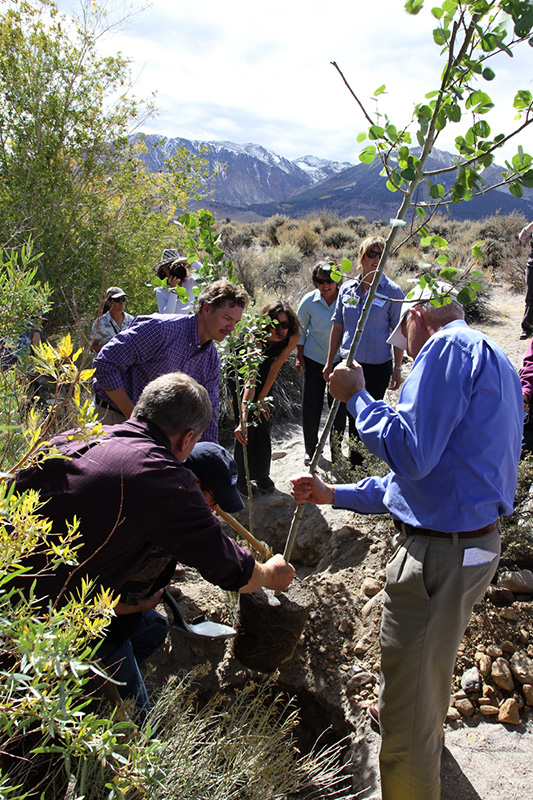

August 27, 2013 simultaneously marked the end of one era and the beginning of another in the history of stream restoration in the Mono Basin. On the top floor of its downtown Los Angeles building, the DWP Board of Commissioners unanimously approved the Stream Restoration Agreement—the final stamp of approval needed among partners California Trout, the Department of Fish & Wildlife, and the Mono Lake Committee.
Finalization of the Agreement marked the end of intensive negotiations that have dominated the last three years of work by the Mono Lake Committee policy team. But Mono Lake history has taught us an enduring lesson: eternal vigilance.
With the Agreement complete, we now turn to implementation. There’s a lot to do, including significant new mandated duties for the Committee. Just as in the past, we have critical work ahead to turn the words of the Agreement into a series of on-the-ground, science-based restoration actions.
2014 will be a busy year
The Agreement lays out an ambitious roadmap to achieve the long-awaited restoration of Mono Lake’s tributary streams. Like all journeys, there’s a lot of work needed to reach the destination.
The Committee is already enthusiastically at work on the key next steps with the goal of arriving at the day when the streams feature trophy trout, lush streamside forests, and abundant wildlife.
• The California State Water Resources Control Board is currently reviewing the Agreement. Only when the State Water Board issues a new water license to DWP will it take effect—something we project could happen this winter. To provide the State Water Board with as many specifics to work with as possible, attorneys and staff from the Committee and the other parties are at work translating the Agreement into proposed license term language, a meticulous project that should be completed by mid-November.
• Independent scientific monitoring: The new Monitoring Administration Team mechanism for administering stream, lake, and waterfowl monitoring has to be created. This winter the parties will get financial management, timelines, duties, and contracts ready so that effective monitoring can take place starting next spring. This is a critical program, and the Committee has an Agreement-mandated oversight role to play.
• Aqueduct operations plan: By the end of 2014 a new multi-year Mono Basin Operations Plan will be completed covering all aqueduct facilities in the Mono Basin and their operation. The Committee’s experts will work closely with DWP to be sure that the State Water Board’s interlinked stream, lake, reservoir, and export rules are all part of the plan.
• Grant Outlet: The Agreement sets a four-year schedule for construction of the outlet, and work is already underway—DWP geotechnical studies are scheduled to take place before the snow falls. DWP has a series of deadlines in 2014 and 2015 regarding design and construction plans, environmental analysis, and permitting. The outlet should be constructed and operational by spring 2018, and the Committee will be tracking progress closely and assisting DWP where helpful.
• Adaptive management: An important Agreement element is the provision that the Stream Scientists may make modifications, within set limits, to the annual streamflows based on their expertise and on new information that comes in via the monitoring program. Discussion of these adaptive management adjustments to flows will involve the Committee and other Agreement parties, both in a planned manner and also in response to rapidly emerging situations such as unusual runoff conditions.
Stay vigilant with us
Visit the creeks when you are next in the Mono Basin and stop by the Mono Lake Committee Information Center & Bookstore to hear the latest status reports. The Mono-logue will have updates as implementation proceeds, and you can expect future Mono Lake Newsletters to provide all the details as we put the Stream Restoration Agreement into action.
This post was also published as an article in the Fall 2013 Mono Lake Newsletter.

Although I’ve followed with interest news from the Mono-logue, I’m not a close visitor that gets info on a weekly or so basis. Hence I may be deficient in my knowledge of terms used, so I just wonder exactly what you mean in the latest issue by the term “Outlet,” a word that I guess most of your readers know the meaning of. I think it likely refers to a modification of the current outlet system for waters from the Mono Basin going into the Los Angeles water delivery system. Just wondering?
Thank you Howard for asking for clarification of the term “Grant Outlet.” We use the term as shorthand for the new Grant Lake Reservoir release facility that the settlement requires be built in order to deliver higher peak stream flows to Rush Creek.
In 1940, DWP built the current dam that enlarged Grant Lake Reservoir (which had already been enlarged one previous time on a much smaller natural Grant Lake on Rush Creek). No direct outlet to Rush Creek was built, but a “waste gate” was built on the outlet conduit that takes water from the reservoir to the Mono Craters Tunnel. This water exported from the Mono Basin flows into the Upper Owens River. That gate was used (only occasionally prior to permanent flows in 1983) to return water to Rush Creek in a mile-long ditch to satisfy irrigation needs. That gate and ditch, rebuilt but still limited to a 380 cfs capacity (a Normal-year peak flow), is the only reliable source of water for lower Rush Creek. The new “Grant Outlet” will augment that capacity to release water directly to Rush Creek in the 40% of years that are wetter-than-normal.